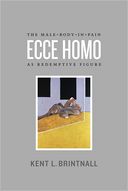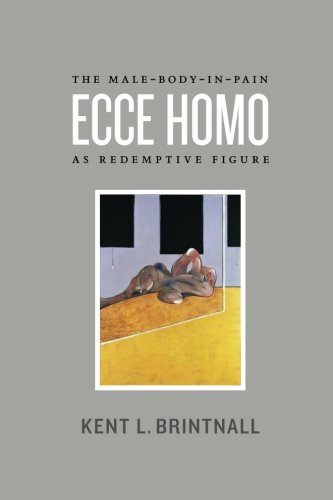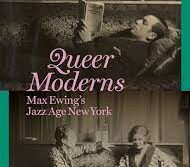 Ecce Homo: The Male-Body-in-Pain as Redemptive Figure
Ecce Homo: The Male-Body-in-Pain as Redemptive Figure
by Kent Brintnall
University of Chicago Press. 220 pages, $32.50
SOME THIRTY YEARS AGO, a young and still controversial Madonna remarked that she liked wearing a crucifix because there was a naked man on it. Religious hand-wringing ensued. At the time, though, many of us—perhaps including a young Kent Brintnall—wondered what the fuss was all about. Wasn’t it obvious that the central symbol of Christianity was an eroticized young man on a cross? This icon is what Brintnall refers to here as a “male-body-in-pain,” foregrounded as the symbol of sacrifice, faith, immanence, and transcendence.
If there were any doubt about these intersections of spirituality and sexuality, Brintnall’s elliptical new book, Ecce Homo: The Male-Body-in-Pain as Redemptive Figure, dispels it handily. Making the case for the deep intresections of mysticism and eros—and drawing heavily on Georges Bataille—he argues that the paradoxical symbol of the compromised male body as a symbol of redemption embodies the “self-shattering and fragmentation” that is erotic and mystical transcendence. Nimbly dancing between the Bible, Robert Mapplethorpe, the artist Francis Bacon, and Hollywood action films, Brintnall concludes that representations of suffering male bodies offer “a chance at glimpsing oneself in the other across the wound’s abyss, a headlong fall of dizzying ecstasy.”
It is because these male bodies are erotically and physically compromised that they become metonyms for the transcended self. For Brintnall, this is what brings together Bacon’s fleshy paintings, Mapplethorpe’s formalized imagery of S/M (the reproduced photos are not for the squeamish), and even pop icons such as Arnold Schwartzenegger (in the “Terminator” movies, which all ravage his body over and over), and Mel Gibson (in pretty much every movie he’s made). Brintnall resists any temptation to photoshop out the brutality of Mapplethorpe’s photographs, and works backward from there to the Crucifixion, which is all about “the brutalization, humiliation, and degradation of a male body.”
There are many ironies here, as Brintnall invites us to “linger in the rain with the battle-scarred Rambo” and “genuinely bid farewell” to the Terminator. Yet these pop-cultural heroes, like their divine antecedent, are symbols of both masculine heroism and vulnerability. Both heroes suffer, both men are permeable, and both suffering and triumph are necessary. The hero is not only he who wins; it is he who suffers as well.
The viewing of the “male-body-in-pain” is of course a homoerotic gaze. Brintnall makes use of Jacques Lacan here (and Freud, and Bataille again) and doesn’t look away. Christ’s body, after all, is naked as well as crucified, just as mysticism is erotic as well as spiritual. Those familiar with other works by Brintnall, who teaches religion at the University of North Carolina, know that his queer theology asks similar questions. In a way, however, Ecce Homo is queerer for declining to present itself in that genre. This is not a book about how gay people see Christ; it is how Christ and Christ figures present themselves for viewing by everybody. The queerness of these narratives is hidden in plain view.
________________________________________________________
Jay Michaelson is the author of God vs. Gay? The Religious Case for Equality (Beacon Press, 2011).





